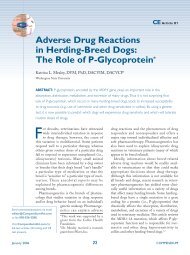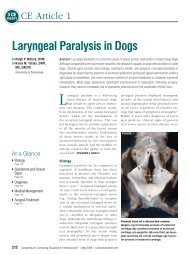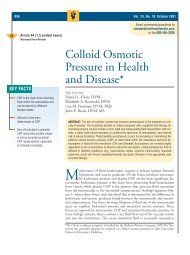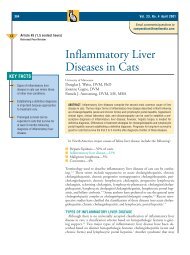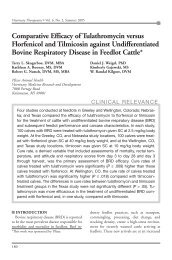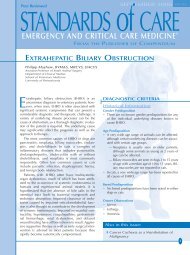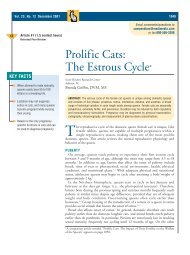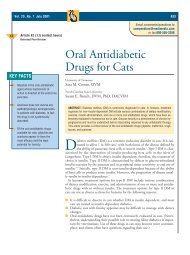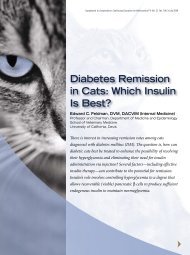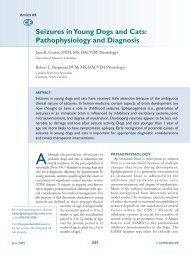Create successful ePaper yourself
Turn your PDF publications into a flip-book with our unique Google optimized e-Paper software.
460 Small Animal/Exotics Compendium June 2002<br />
Table 7. Antimicrobials<br />
Drug Dose Indication Comment<br />
Ampicillin/ Dogs and cats: 10–20 mg/kg Gram-positive bacteria, Disrupts normal GI flora<br />
amoxicillin PO, IM, or IV q6–8h anaerobes<br />
Cephalexin Dogs and cats: 22 mg/kg PO Gram-positive bacteria, Disrupts normal GI flora; give<br />
q8–12h some gram-negative bacteria;<br />
mucosal injury, sepsis<br />
with food if vomiting occurs<br />
Metronidazole Dogs and cats: 10–20 mg/kg Bacterial overgrowth, Neurotoxicity at higher<br />
PO q8–12h anaerobes, IBD, Clostridium, doses; use one third of dose<br />
Giardia if liver disease is present<br />
Erythromycin Dogs and cats: 10 mg/kg PO q8h Campylobacteriosis Can cause GI upset<br />
Enrofloxacin Dogs: 2.5–5.0 mg/kg PO or IM Gram-positive bacteria, gram- Can cause cartilage<br />
q12h; cats: 2.5 mg/kg PO or IM negative bacteria, sepsis defects in puppies (if given<br />
q12h >5 mg/kg) and possible<br />
blindness in cats<br />
Sulfasalazine Dogs: 10–30 mg/kg PO q8h; IBD, colitis Can cause keratoconjunccats:<br />
20 mg/kg or 250 mg PO q8h tivitis sicca; use with caution<br />
(three times), then q24h in cats because of possible<br />
salicylate toxicity<br />
Tetracycline Dogs and cats: 20 mg/kg PO q8h Bacterial overgrowth, Can cause liver toxicity,<br />
hydrochloride rickettsial diarrhea, sepsis GI upset, discolored teeth<br />
(in puppies), drug fever<br />
(in cats)<br />
Gentamicin sulfate Dogs and cats: 2.2 mg/kg IM, Sepsis Can cause nephrotoxicity;<br />
IV, or SC q12h do not use in dehydrated<br />
patients or those with renal<br />
disease<br />
Tylosin Dogs and cats: 11–200 or Bacterial overgrowth, IBD Sprinkle on food; broad dose<br />
20–40 mg/kg PO q12h; range with wide safety<br />
5–10 mg/kg PO q8–12h; margin; each gram contains<br />
1 /4–1 tsp with food q8–12h 100 mg tylosin<br />
Trimethoprim Dogs and cats: 15 mg/kg PO Mucosal injury, gram-negative Immune disease (in liver,<br />
sulfonamide or SC q12h bacteria, Salmonella, coccidia bone marrow) is a possible<br />
reaction<br />
diarrhea but are not effective on<strong>ce</strong> clinical illness is apparent.<br />
Bismuth subsalicylate has been shown to have<br />
antiprostaglandin synthetase effects that enhan<strong>ce</strong> the ability<br />
to control diarrhea caused by the subsalicylate <strong>com</strong>ponent.<br />
This <strong>com</strong>pound should be used cautiously in cats<br />
because the subsalicylate is absorbed systemically and toxicity<br />
is associated with use of this drug in cats. 1<br />
Activated Charcoal<br />
Activated charcoal, which is a <strong>com</strong>monly used adsorbent<br />
to treat intoxications from ingestion of harmful drugs<br />
or substan<strong>ce</strong>s, absorbs the toxin in the gut and decreases<br />
the amount of toxin entering the systemic circulation. If<br />
the drug or toxin is eliminated by the liver and reabsorbed<br />
in the in<strong>test</strong>ine, activated charcoal can absorb the toxin<br />
and increase the rate of elimination from plasma and tis-<br />
sues. Timing of treatment is important for maximal efficacy,<br />
and delays of even 30 minutes can decrease absorption<br />
substantially. Activated charcoal is available in readymade<br />
liquid, powder, or tablet form; the liquid and<br />
powder forms are more absorptive than the tablets.<br />
Cholestyramine<br />
Cholestyramine is the chloride salt of a basic anion<br />
exchange resin and acts by forming ionic bonds with<br />
acidic side chains. 13 This drug is known for its bile<br />
acid–binding capacity and is used for bile acid–indu<strong>ce</strong>d<br />
diarrhea following resection of the ileum. Cholestyramine<br />
can interfere with in<strong>test</strong>inal absorption of drugs<br />
(e.g., chlorothiazide, phenylbutazone, phenobarbital,<br />
anticoagulants, thyroxine, digitalis) and can be used to<br />
treat intoxication. Side effects include hypochloremic



